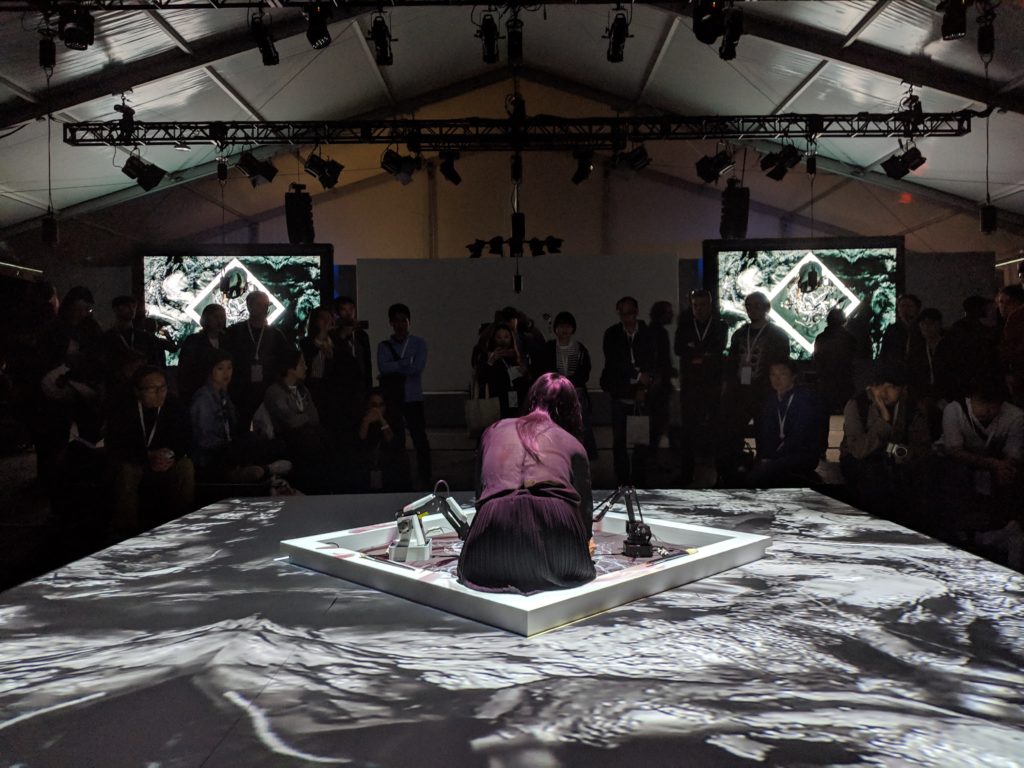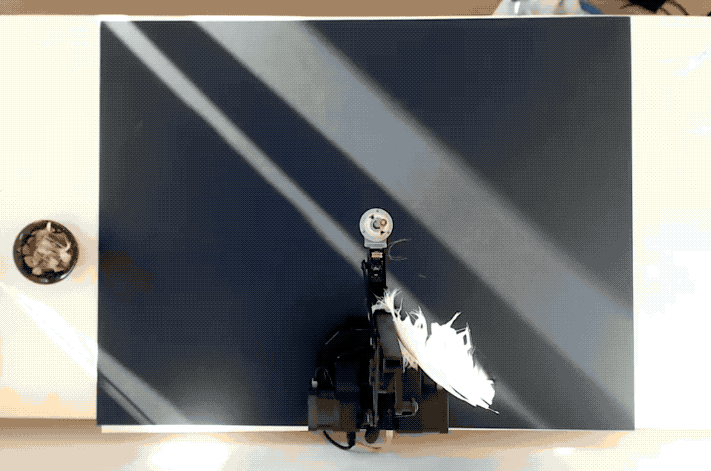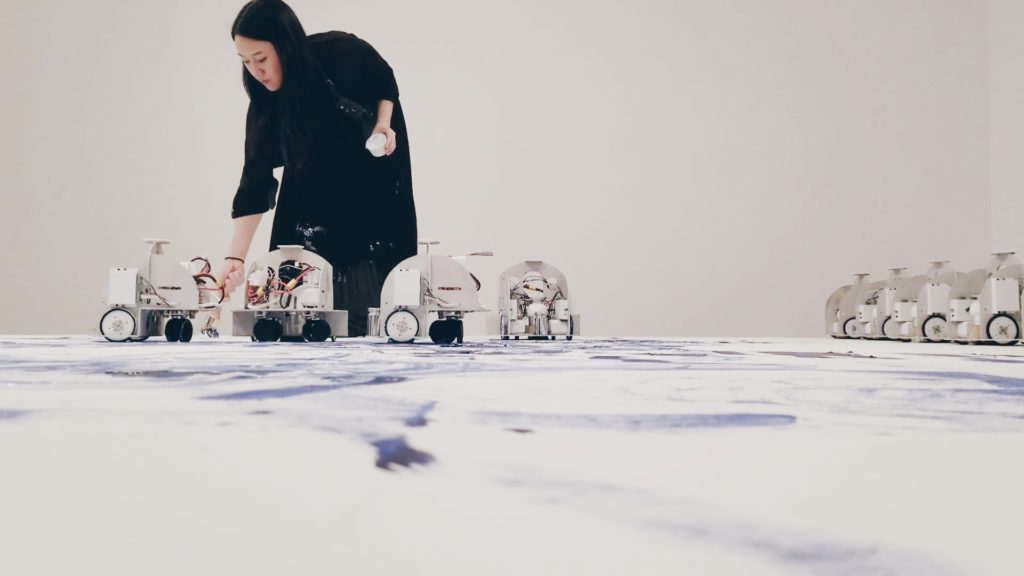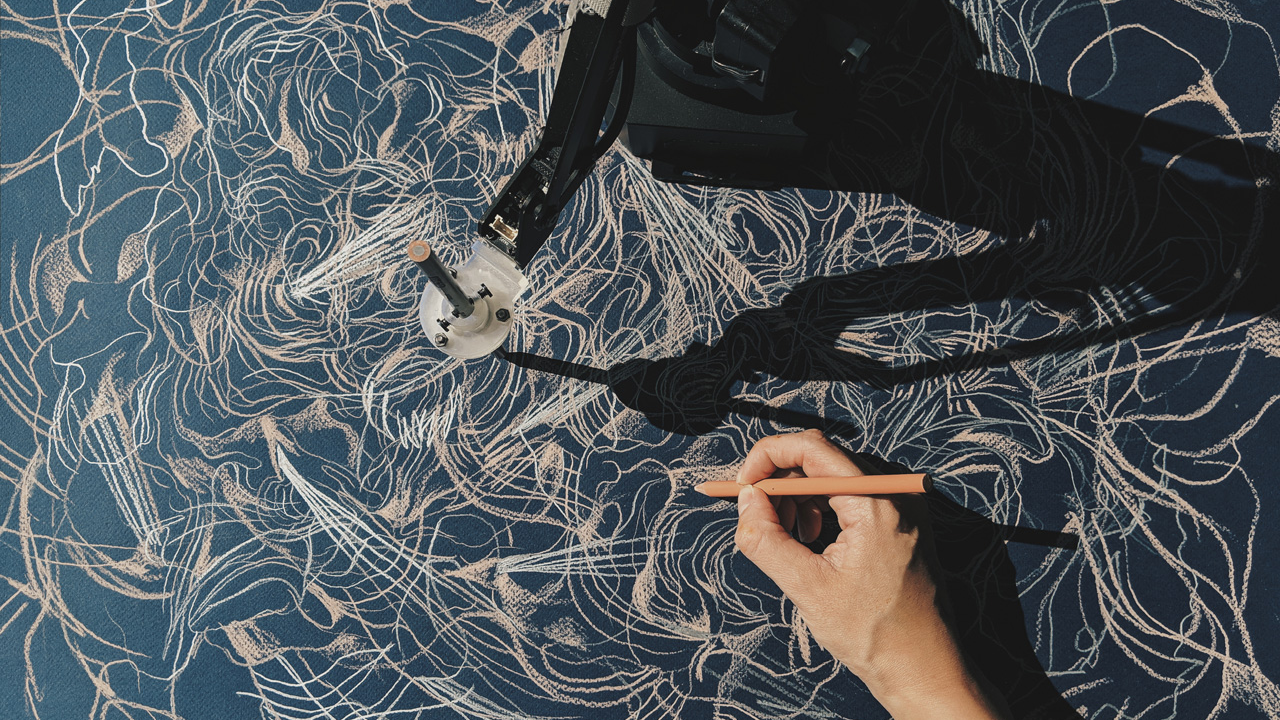LATE LAST YEAR, artificial intelligence made a loud splash in the art world. A trio of French students, calling themselves Obvious, put a smeared, unfinished portrait up for auction at Christie’s. Titled Portrait of Edmond de Belamy, the murky image pictured a suited gentleman with a plain white collar. Rendered in three-quarter profile against an indistinct background, the image mimicked conventions from Renaissance and Baroque portraiture. At the corner of the canvas, a mathematical equation ostentatiously replaced the traditional artist signature. Global media trumpeted the achievement as a stunning first. Obvious oiled its promotional engine by misleadingly claiming it to be the first ever work of art created by AI to go under the hammer. Neither claim turned out to be true: significant human labor went into its making, and a set of AI-generated images had gone to auction at San Francisco’s Gray Area in 2016. Offered at $10,000, the image went to an anonymous buyer for a jaw-dropping $432,000.
This portrait embodies significant problems at the heart of AI’s recent cultural ubiquity. Machine learning is being used across art, science, and industry — from music production to space exploration — but its excursions into the creative economy have ignited the most controversy. Commonly, such works lead to the question, “Can a machine be creative?” But this question misses the mark.
AI is the latest, most intangible incarnation of the automated arts. When it comes to creative automatons, history shows we’ve been rehearsing the same hand-wringing about authorship and authenticity for over a century. The history of photography, for example, famously raised alarms about humans surrendering the arts to machines. While automatons are now largely digital, not strictly mechanical, they, too, seem to imperil the ostensibly humanist essence of art. But Portrait of Edmond de Belamy did not spring fully formed from the neural network’s “mind.” Rather, it emerged out of a complex system where human actors continue to play a crucial role, although the story of their absence — and abdication of the arts — persists.
Obvious worked with an artificially intelligent system known as a generative adversarial network, or GAN. An algorithm composed in two parts, a GAN reproduces an agonistic relationship between artist and critic. The Generator creates new images based on a massive data set, and the Discriminator evaluates that image against a human-made image. Obvious trained their GAN on a data set of 15,000 portraits from the 14th to the 20th century. Ensconced in a gilded frame, and gorged on the Western canon, the image convincingly reproduced the aesthetic conventions of portraiture. By signing the image with a segment of the algorithm’s code, Obvious had, in a clever sleight of hand, cast an algorithm as a stand-in for the absent hand of the artist.
But the artist in question was not, actually, a hypothetical person. Obvious had appropriated their code, as well as the training set, from Robbie Barrat. Then a 19-year-old artist and programmer, Barratt had shared his Old Masters GAN on the open-source sharing website, Github, in 2014. An outcry from the small community of AI artists punctuated the auction. They not only emphasized Barrat’s erased contribution but also expressed disbelief that the amateurish image was representing their years of creative experimentation with GANs to the world at large. In their rush to crown the algorithm as the work’s author, Obvious obscured the central roles played by humans in the conception, coding, and curation that yielded the image. If this was an aesthetic Turing test, then we have willfully failed it. But why?
The equation at the traditional site of the artist’s signature offers some clues. This staging culminates a centuries-old conversation about the agency of creative automatons. Signatures boast a special connection to the human hand. Historically, they have imprinted the heft of the human body upon an object, whether artwork or legal contract. They index the identity of the signer: they affirm that someone was really there. By displacing a human signature with an algorithm, Obvious manifested an obscured predecessor in the history of automated art — not the camera, but the player piano. Yes, that classic piece of ragtime furniture.
¤
Popular in the early 20th century, player pianos are a mechanical incarnation of the absent human hands in AI-generated art. Anyone who has seen a player piano in action can attest to its uncanny nature. Once in motion, one can almost imagine an invisible player sitting at the instrument. Piano keys seem to play themselves in cheerful ragtime. Now largely a relic of a different time, the player piano stirred many of the same kinds of questions and debates that AI art does now.
Inventor Edwin Votey built a prototype of his automated player piano system in 1895. It took the form of a large wooden cabinet, and was powered by suction generated by two foot pedals. It was designed to stand in front of an existing piano, where mobile fingers at its rear would orchestrate its keys. Astride the piano, this cabinet of curiosities contained a small paper roll patterned with tiny perforations representing notes to be played. As a roll moved over the tracker bar, a reading device with a row of evenly spaced holes, a valve would open and trigger a pneumatic motor. This would then fire a felt-covered finger on the external player, causing it to hit the corresponding piano key. Though these functions soon entered the instrument itself, with the introduction of the Apollo line of pianos by the inventor Melville Clark in 1901, these operational principles remained the standard for nearly all roll-operated player piano systems.
In the next decade, the machine developed into a ghostly rendition of human performance. In 1904, German organ builder Edwin Welte and his school friend Karl Bockisch launched a new kind of player piano, the Welte-Mignon. Otherwise known as a reproducing piano, these were able to record and reproduce individual performances by replicating the dynamics, rubato, and pedaling of living players. In its heyday, music roll manufacturers recorded the performances of many famous 20th-century pianists, George Gershwin, Liberace, Jelly Roll Morton, Myra Hess, and Thomas “Fats” Waller among them. Specters of performances past, these rolls conjure the apparitions of nearly every major early 20th-century pianist.
For all its commercial success, the automated instrument drew its share of criticism. In 1906, John Philip Sousa published “The Menace of Mechanical Music,” a screed against the sweeping popularity of player pianos and gramophones. Sounding the alarm about these poor copies, Sousa fretted that these “talking and playing machines” “reduce the expression of music to a mathematical system of megaphones, wheels, cogs, disks, cylinders, and all manner of revolving things, which are as like real art as the marble statue of Eve is like her beautiful, living, breathing daughters.” For Sousa, these creative automatons substituted cogs and wheels for the ineffable human soul.
Creaky in their physicality, the player piano seems a far cry from the digital machines so ubiquitous today. However, the rolls that powered their spectral movements form a bridge with the artificially intelligent systems that generate such images as Portrait of Edmond de Belamy. After all, with the sleek miniaturization of contemporary computing, it is easy to forget that the early computers of the 1940s and ’50s were massive calculators operated by punch cards with holes in them. In these pockmarked landscapes, the automated arts, from player pianos to algorithm-generated portraiture, took root.
As William Gaddis decried in Agapē Agape, his 2002 swan song on the ruination of art by technology, “There was the beginning of key-sort and punched cards and IBM and NCR and the whole driven world we’ve inherited from some rinky-dink piano roll.” The narrator of Gaddis’s pseudo-autobiographical novel lies dying in his hospital bed. He pores over his notes in a desperate rush to finish his magnum opus, a history of the player piano. Paralleling his deteriorating body with the decay of culture, he rages against a commercialized world where art has become mere entertainment, and imitation has displaced authenticity.
Gaddis is not alone in placing the player piano in the history of computational creativity. The recent TV show Westworld also winks at this past. The show envisions a world where guests pay to play in a live-action simulation of the Wild West, replete with cowboys, gun battles, and damsels in distress. Euphemistically named “hosts,” androids in period boots and hats, are at the mercy of the human “guests” who come to ravish, maim, or kill them. In the saloon where guests down whiskey and manhandle artificial women, a player piano sits. Phantom hands alight on the keys; tinkly covers of contemporary songs serve as a soundtrack for gun battles and seduction. As robotic copies of humans cavort among originals, these mechanized cover songs evoke the longer lineage of artificial others.
Despite the century that has passed since their debut, player pianos, like androids, remain eerie, ghostly objects on the brink of life. In a pantheon of creative automatons, the player piano endures for the existential questions it provoked. How have these automated instruments transformed the landscape of creativity? And at what cost?
¤
New technologies demand new visions of how we might use them. AI technologies have been accused of reproducing the invisible human structures that inhere in the data from which they learn, including the best and worst of us. Take Portrait of Edmond de Belamy. Not only did it regurgitate musty art historical conventions, but its success affirmed the gatekeeping function of the auction house, as well as the conflation of monetary worth with artistic value. Where Obvious’s image replicates some of the least compelling elements of the art world, other AI artists imagine other ways we might relate to these creative machines.

Drawing Operations Duet (Performance)
Against a narrative of imperiled human creativity, some artists working with AI instead frame these new technologies within an ecology of human and machine collaboration. In Drawing Operations, the artist Sougwen Chung stages a series of collaborative drawing performances with a robotic arm. In three chapters, “Mimicry,” “Memory,” and “Future Speculations,” Chung showcases an evolving robotic behavior based on her research with art and AI. Ongoing since 2015, the work highlights the complexities of assigning authorship to AI.
In Generation 1 of the project, Chung explored robotic mimicry in real time. By capturing her drawing gestures with an overhead camera and analyzing them with computer vision software, the robotic arm replicated her movements. The robot precisely duplicated the pace, shape, and style of the original performer. In many ways, we might understand this arm as a 21st-century version of Votey’s player piano, the mechanical fingers of his wooden cabinet playing the keys in the absence of a human performer. But Chung turns this dynamic on its head. After all, her body was actually present, the robotic arm a proxy for her in the same moment. Their gestures synchronized as they made marks on paper, Chung and her robotic double formed a strange duet.

Artefact 1 (Process)
In Generation 2 of Drawing Operations, the robotic arm was linked to a neural network trained on a database of Chung’s extracted gestures from previous drawings. As a result, the robotic arm was able to generate new movements and drawings in Chung’s style, without duplicating them exactly as it had prior. In improvised performances, Chung draws in tandem with the arm, creating abstract line drawings that blur her marks with those of her robotic collaborator. Speculating on artificial creativity, Drawing Operations suggests a more complicated entanglement of human and machine actors than prevailing media narratives suggest. Through these performances, Chung systematically imagines a creative future where automatons might extend human intelligence.
As the perforated rolls of the player piano prefigured the punch cards of early computing, so, too, have they shaped how we talk about creative machines. Like the ghostly hands that played upon pianola keys, AI art stokes deep cultural anxieties about the risks automation poses to human activity. Ultimately, we fear that they will replace us, whether at the factory or at the canvas.
While the story of absent human hands lingers from the heyday of the player piano, the stakes have changed. For all the controversy it stirred, the player piano was ultimately only a reproducing musical robot, unable to deviate from its punched script. It was also an industrial invention, symptomatic of rapidly changing modes of production. In a creative economy, where factory jobs are all but gone, creativity is just another commodity. The risk is not that humans will stop being creative but that they will cede the signs — and compensation — of their labor to algorithmic signatures.
By demonstrating AI artworks’ commercial viability, Portrait of Edmond de Belamy sparked a gold rush. Shortly after the notorious auction, computer scientist Ahmed Elgammal debuted the creative output of AICAN, his GAN variant, in a Chelsea gallery. Unlike Edmond de Belamy, these pieces, collected under the title Faceless Portraits Transcending Time, were pitched as a joint effort between man and machine. While many images from the show ostensibly sold for five figures, AICAN’s financial ambitions are far higher. Based on its success identifying the chronology of the images in its data set, Elgammal and his investors believe it could be used to anticipate — and produce — future art trends. Unchecked, these virtual automatons could theoretically cut human artists out of the art market entirely. The fears of Sousa and Gaddis could, in fact, be realized.

Omnia per Omnia (Performance)
But rather than allow this threat to send us into a technophobic spiral, we could instead, like Sougwen Chung, conceive of humans and machines as interacting parts of complex adaptive systems. Whether creative duet, industrial partnership, global economy, or internet, these complex systems have marked all of human history. So imagined — and so designed — intelligent machines can serve to amplify and augment human activity. It is neither us nor them, but both.
¤
